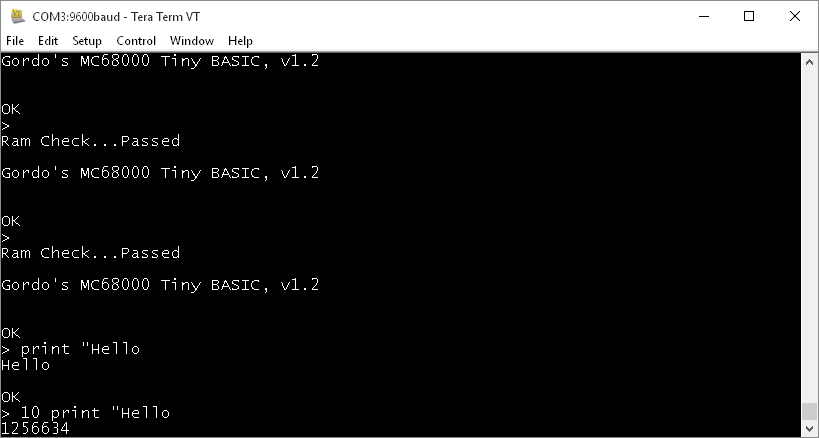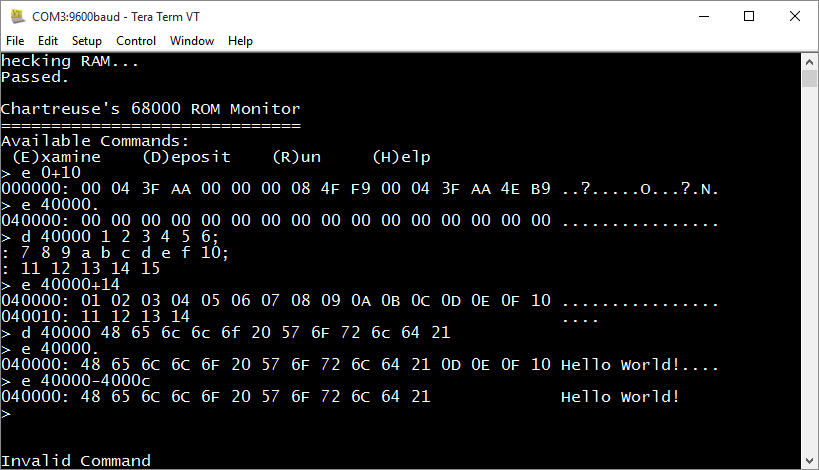
So a lot has changed since my last update on here, I've redone the address decoding to use a 74138 3-8 line decoder to allow me to partition the address space. I've added some status LEDs to help show the state the computer is sitting in, so I don't need to break out the logic probe as often. And the final, and probably the most important, addition is that I've added a 68681 Duart chip, giving me a means of input and output.
The 68681 chip wasn't a too difficult of a chip to add in, you just need to map it into the address space with it's chip select, attach it's 4 register select lines to the address bus, and tie it's 8 data lines onto one of the data buses. The other thing that adding it changed was necessitating me to add some /DTACK logic, rather than just grounding it, as the 68681 puts out a dtack signal. This was accomplished by using one of the open collector inverters to ground /DTACK when the 68681 isn't selected, but when it is selected it passes the /DTACK signal from the 68681 through a resistor to the 68000.
On the software side of things, my first tests were to get the 68681 to output something useful, for a while I wasn't succeeding and ended up putting the project on hold for a while. Fast forward to a couple weeks ago, I sat down to try and get it working again, and after writing the initialization code again (with the help of some online resources) I managed to get a Hello World! out of it. My computer was finally properly working.
My next thought was to try and get a simple BASIC interpreter ported over to it, I quickly found a 68000 version of Tiny BASIC, which I modified the I/O to match my setup. As well as changing where it assumed RAM was. After quite a bit of debugging I finally got it to a partially working state as shown below.

I was able to get it to do get it to do a few things in interactive mode, namely the PRINT statement, but when I tried to store a program line, it would lock up. I tried doing some debugging over the serial port (hence the 1256634 on the last line) but what it was doing wasn't making much sense. In the end I was getting frustrated with it and moved on to writing my own program for the machine from scratch.
Enter my ROM Monitor. I decided I wanted to have a simple ROM Monitor program that would let me examine memory, deposit values into memory, as well as jump and execute to any address. I used this project as a way of getting some experience coding 68k assembly, as this computer is the first time I had done so. MarkeyJester's 68k Tutorial was a very nice reference for quickly learning the instructions I needed. Since I didn't want to spend all the time debugging over the serial port, flashing many ROMs and such I chose to use the built in simulator in Easy68k. What I did was write the I/O routines into functions that used the simulators I/O routines, so that when I was ready I'd swap in the routines I had written for the Tiny BASIC. After getting the monitor working as I wanted it in the simulator I finally flashed it to my ROM. Now it would have been great if it had worked perfectly first time, but there turned out to be a bug, when the examine function was told to examine more than 16 bytes at a time it would increment the address by 0x110 bytes instead, after a bunch of debugging I found the culprit, I was using only a byte of r4 (and so was using .b instructions), but I was doing a suba.l with it on an address, thus in the simulator where r4 was initialized to 0, it would work since the upper bytes were all 0, but on the real hardware where r4's initial state was unknown it failed. After fixing the code to initialize r4 and r3 in the dumpRAM routine, it worked perfectly on the real hardware.

Now as for what I'll be doing next, I'm not too sure. I may start with merging this and my arduino NTSC serial terminal project to give this computer a real computer feel. And having a TV output and keyboard would definitely do that. I also might give another try to porting a BASIC interpreter to it.
I posted my monitor over to my github if anyone feels like taking a look at it and/or using it. https://github.com/ChartreuseK/68k-Monitor
 Hayden Kroepfl
Hayden Kroepfl
Discussions
Become a Hackaday.io Member
Create an account to leave a comment. Already have an account? Log In.